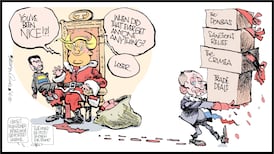The unexpected fall in support for Sinn Féin in last month’s local and European elections has obscured an even more remarkable feature of the result: the performance of the two big Government parties which, if repeated in the general election later in the year, will give them a clear overall majority.
This is something that was not even considered a remote possibility before last month’s contest revealed an entirely new political landscape. The elevation of Simon Harris to the Taoiseach’s office was the key factor in transforming the political mood and prompting a new voting pattern which helped both Government parties.
At first glance, the share of the vote obtained by Fine Gael and Fianna Fáil appears respectable rather than impressive. The parties each won 23 per cent of the first preference vote in the local elections and a little under 21 per cent in the European elections.
What turned a respectable outcome into a truly impressive one was the seat bonus achieved by each of the parties. In the local elections, the identical 23 per cent of the vote achieved by Fine Gael and Fianna Fáil translated into 26 per cent of the seats for each.
READ MORE
If they could pull off a similar result in the general election they would each win 47 seats in the 178 member Dáil, giving them a reasonable working majority of 94 seats.
The seat bonus in the European elections was even more impressive. With just under 21 per cent of the first preference vote, each party won almost 29 per cent of the seats. A repeat performance in the autumn would give each of them 52 seats and a thumping majority in the next Dáil.
The reason the parties won such an impressive seat bonus was down to two factors. One was the unprecedented level of transfers between candidates from the two parties and the other was the splintering of the anti-Government vote between a large cast of smaller parties and Independents.
The election of Cynthia Ní Mhurchú in Ireland South was an example of how Fine Gael transfers helped Fianna Fáil win two seats out of five. After the elimination of the second Fine Gael candidate, John Mullins, there were two crucial transfers that helped her over the line. The first was on the elimination of Mullins himself when she received 43 per cent of his second preferences, but the key one was on the final count with the distribution of Billy Kelleher’s surplus. Those surplus votes had come from Mullins’s first preferences and nearly 17,000 of them, or 63 per cent of the total available, transferred to Ní Mhurchú on the 20th and final count, putting her comfortably ahead of Mick Wallace.
Good transfers from Fine Gael to Fianna Fáil were half expected given the wide respect earned by Micheál Martin among Fine Gael voters during his term as taoiseach. The question was whether the favour would be returned, in light of the ongoing grumbling about the Coalition in some Fianna Fáil quarters – but as it turned out this was not an issue.
A dramatic illustration was the outcome in the Blackrock ward for Dún Laoghaire-Rathdown council. Going into the last count, which involved the transfer of a Fianna Fáil surplus of 45 votes, the Independent candidate, Cormac Lucey was 11 votes ahead of Fine Gael candidate Dan Carson and just one behind the other remaining Fine Gael candidate, Maurice Dockrell. Remarkably, 35 of the 45 Fianna Fáil surplus votes transferred to the Fine Gael candidates and, even more remarkably, the split was almost even with 18 going to Carson and 17 to Dockrell. The result was that Carson won the seat by just two votes ahead of Lucy, while Dockrell had 13 to spare.
This was the kind of voting discipline that Fianna Fáil and Fine Gael struggled to achieve even for internal party transfers over the years. The fact that it happened across the country without any formal voting pact between the parties was remarkable. It showed that voters were well able to draw their own conclusions about how to maximise the impact of their ballots without any direction from their political leaders.
A similar level of transfers in the general election will win extra seats for both parties, which is why it is vital that they go into the contest on good terms with a unified approach to seeking a new mandate.
The other important factor is whether the anti-Government vote will be as fragmented, and that is unlikely. Sinn Féin will almost certainly improve on its dismal 12 per cent showing last month, given the number of incumbent TDs, and it will be no surprise if the party wins about 20 per cent. However, Sinn Féin won’t have the anti-Government vote to itself, as it did in 2020, and will have to contend with challengers from smaller left-wing parties and the newly emerging forces on the right.
A lot could happen between now and late autumn, but the two big Government parties are in a far better position on the eve of the election than they expected just a short few months ago.














